James Henry Lane
(June 22, 1814 – July 11, 1866)
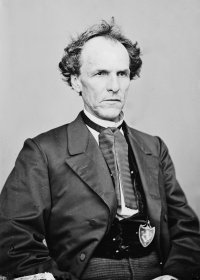 James Henry Lane was a prominent figure in establishing Kansas as a “free state.” As a key figure in “Bleeding Kansas,” he also terrorized the inhabitants of Missouri counties sharing a border with Kansas. Lane would use his jayhawking tactics during the Civil War while leading the Kansas Brigade.
James Henry Lane was a prominent figure in establishing Kansas as a “free state.” As a key figure in “Bleeding Kansas,” he also terrorized the inhabitants of Missouri counties sharing a border with Kansas. Lane would use his jayhawking tactics during the Civil War while leading the Kansas Brigade.
Pre-Civil War Role
James Henry Lane was born in Lawrenceburg, Indiana on June 22, 1814. His father, Amos Lane, was a lawyer and a Democrat in the Indiana House of Representatives. Amos Lane served two terms representing Indiana in the US House of Representatives. Admitted to the Indiana Bar in 1840, James Henry Lane soon became interested in politics and ran for a seat in the Indiana state legislature in 1845. He did not win the seat.
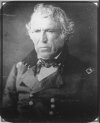
 In 1846, war Mexico broke out and James Lane volunteered and was commissioned a Captain in the Dearborn Volunteer Company, Third Regiment Indiana Volunteers. He was voted as the regimental Colonel on June 24, 1846. His regiment was assigned to General Zachary Taylor's army and participated in the US victory at the Battle of Buena Vista against an army led by Mexican General Santa Anna. Later in the war, Lane reorganized the regiment at the Fifth Regiment Indiana Volunteers and was part of General Winfield Scott's army in the campaign against Mexico City. Lane was appointed as the Provost Marshall for Mexico City. He returned from the war as a hero and re-entered the political arena. Elected as Indiana Lieutenant Governor in 1849 and subsequently to the US House of Representatives in 1852.
In 1846, war Mexico broke out and James Lane volunteered and was commissioned a Captain in the Dearborn Volunteer Company, Third Regiment Indiana Volunteers. He was voted as the regimental Colonel on June 24, 1846. His regiment was assigned to General Zachary Taylor's army and participated in the US victory at the Battle of Buena Vista against an army led by Mexican General Santa Anna. Later in the war, Lane reorganized the regiment at the Fifth Regiment Indiana Volunteers and was part of General Winfield Scott's army in the campaign against Mexico City. Lane was appointed as the Provost Marshall for Mexico City. He returned from the war as a hero and re-entered the political arena. Elected as Indiana Lieutenant Governor in 1849 and subsequently to the US House of Representatives in 1852.
Originally, Lane was not an ardent abolitionist. While a member of US Congress from Indiana, he did caste a vote for the Kansas-Nebraska Act of 1854. He decided not to run again and emigrated in 1855 to the Territory of Kansas. Lane would soon become involved in territorial politics as a member of the Free State Party.
Lane was be elected as a Brigadier General of the Free State Militia and subsequently directed the construction of fortifications in Lawrence, Kansas during the Wakarusa War that took place in late 1855. On December 1, 1855 a small army of Missourians, acting under the command of Douglas County, Kansas Sheriff Samuel J. Jones, entered Kansas and laid siege to Lawrence. But the fortifications were formidable enough that the invaders chose to negotiate and both sides agreed to a peace treaty. James Henry Lane was directly involved in the negotiations.
Lane took his militia on the offensive during 1856, subduing pro-slavery forces at Franklin, Fort Saunders and Fort Titus before marching against pro-slavery forces in the territorial capital in Lecompton, Kansas. US Army forces intervened before there was a fight, but Lane secured the release of several Free State prisoners being held there.
Following the Free State victory in territorial elections in October 1857, the Kansas Legislature made Lane a Major General of the Kansas Militia.
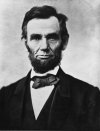 Sometime in December 1859, Lane met Abraham Lincoln on a campaign stop in Kansas. Impressed with the presidential candidate, Lane would speak and raise money on behalf of Lincoln's campaign throughout the northern states.
Sometime in December 1859, Lane met Abraham Lincoln on a campaign stop in Kansas. Impressed with the presidential candidate, Lane would speak and raise money on behalf of Lincoln's campaign throughout the northern states. 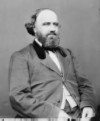 Following Lincoln's election, Lane wrote to Lincoln telling Lincoln that he could raise a brigade of Kansans to serve as an armed guard for Lincoln's inauguration.
Following Lincoln's election, Lane wrote to Lincoln telling Lincoln that he could raise a brigade of Kansans to serve as an armed guard for Lincoln's inauguration.
On January 29, 1861, Kansas became the 34th state in the Union. On April 4th, the Kansas Legislature elected James Henry Lane and Samuel C. Pomeroy as the state's first US Senators.
Civil War Role
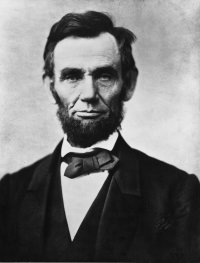 In April, 1861 following the Confederate attack on Fort Sumter and the seizure of the federal arsenal at Harpers Ferry, Lane, in Washington to begin his Senate term, organized a volunteer company of men called the Frontier Guard. Its purpose was to provide protection for Washington from the Southern threat. Lane's Frontier Guard would actually occupy the White House for a few days to provide protection for President Lincoln.
In April, 1861 following the Confederate attack on Fort Sumter and the seizure of the federal arsenal at Harpers Ferry, Lane, in Washington to begin his Senate term, organized a volunteer company of men called the Frontier Guard. Its purpose was to provide protection for Washington from the Southern threat. Lane's Frontier Guard would actually occupy the White House for a few days to provide protection for President Lincoln.
The Kansas Brigade
 On the authority of President Abraham Lincoln, Lane returned to Kansas to raise two volunteer regiments to support the Union war effort. On June 20, 1861, Lincoln had sent a memo to his Secretary of War, Simon Cameron.
On the authority of President Abraham Lincoln, Lane returned to Kansas to raise two volunteer regiments to support the Union war effort. On June 20, 1861, Lincoln had sent a memo to his Secretary of War, Simon Cameron.
“I have been reflecting upon the subject, and have concluded that we need the services of such a man out there at once; that we better appoint him a brigadier-general of volunteers today, and send him off with such authority to raise a force as you think will get him to actual work quickest.”
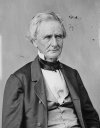 In raising this brigade, Lane would once again butt heads with Kansas Governor Charles Robinson. Normally, the governor was responsible for raising regiments for induction into Federal service. Lane, on Lincolns order, would be circumventing this process. The US Secretary of War, Simon Cameron, sent the following message to Lane on June 20, 1861:
In raising this brigade, Lane would once again butt heads with Kansas Governor Charles Robinson. Normally, the governor was responsible for raising regiments for induction into Federal service. Lane, on Lincolns order, would be circumventing this process. The US Secretary of War, Simon Cameron, sent the following message to Lane on June 20, 1861:
“This Department will accept two regiments for three years or during the war in addition to the three regiments the Department has already agreed to accept from the Governor of Kansas, to be raised and organized by you in Kansas.”
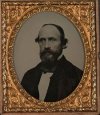 Lane actually did not formally accept his appointment as a Brigadier General, for it would have required him to resign his seat in the US Senate. As it turned out, Kansas Governor Charles Robinson tried to take advantage of Lane's appointment and used his authority to appoint Lane's replacement in the US Senate. But Lane was able to successfully fought off Robinson's attempt and remained one of the senators from Kansas.
Lane actually did not formally accept his appointment as a Brigadier General, for it would have required him to resign his seat in the US Senate. As it turned out, Kansas Governor Charles Robinson tried to take advantage of Lane's appointment and used his authority to appoint Lane's replacement in the US Senate. But Lane was able to successfully fought off Robinson's attempt and remained one of the senators from Kansas.
By late July 1861 Lane's Brigade would have the following organization:
- 3rd Kansas Volunteer Infantry Regiment commanded by Colonel James Montgomery
- 4th Kansas Volunteer Infantry Regiment commanded by Colonel William Weer
- 5th Kansas Volunteer Cavalry Regiment commanded by Colonel Hampton P. Johnson
- 6th Kansas Volunteer Cavalry Regiment commanded by Colonel William R. Judson
- 7th Kansas Volunteer Cavalry Regiment commanded by Colonel Charles R. Jennison
- 8th Kansas Volunteer Infantry Regiment commanded by Colonel Henry W. Wessels.
After the US Congress's special session had ended, Lane returned to Kansas to take command of his brigade. Technically, Lane had still not accepted his appointment as a Brigadier General of Volunteers. In late August following the Union defeat at the Battle of Wilson's Creek, he moved his men to Fort Scott, Kansas.
While in Fort Scott, Lane sent scouting parties into Missouri. These scouting parties always succeeded in returning to Fort Scott with cattle, sheep and other contraband that had been liberated from Missourians that lived in the border counties.
He would direct the construction of fortifications on the north bank of the Little Osage River, calling the location Fort Lincoln. On August 25th, Lane wrote to Captain W. E. Prince, the commander at Fort Leavenworth, describing the distribution of his forces:
“There are now at Fort Scott about 1,200 men, say 600 cavalry, and about the same number of infantry, including the little artillery. The cavalry will be employed in defending the border and dispersing such parties as they can reach. The infantry are drilling industriously, and all at work filling up their companies. At this point we have two companies, about 100 men, engaged in erecting intrenchments and drilling.
“Three miles in advance on Fish Creek, on the road to Fort Scott, we have 40 men; 5 miles below, at Barnesville, 3 miles from the line, on this river, on the military road from Kansas City to Fort Scott, we have about 100 men intrenched and drilling; at Mound City we are fortifying, to be manned by the local militia.”
Lane's Jayhawkers
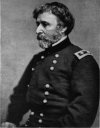 Lane's “scouting parties” were causing consternation for some of his rivals. On September 1, 1861, Kansas Governor Charles Robinson sent a message to Union Commander Major General John C. Fremont warning him of the dangers posed by the Kansas Brigade:
Lane's “scouting parties” were causing consternation for some of his rivals. On September 1, 1861, Kansas Governor Charles Robinson sent a message to Union Commander Major General John C. Fremont warning him of the dangers posed by the Kansas Brigade:
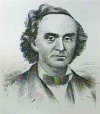 “It is true small parties of secessionists are to be found in Missouri, but we have good reason to know that they do not intend to molest Kansas in force until [Claiborne Fox] Jackson shall be reinstated as governor of Missouri. ... But what we have to fear, and do fear, is that Lane's brigade will get up a war by going over the line, committing depredations,and then returning into our State. This course will force the secessionists to put down any force we may have for their own protection, and in this they will be joined by nearly all th& Union men of Missouri. If you will remove the supplies at Fort Scott to the interior, and relieve us of the Lane brigade, I will guarantee Kansas from invasion from Missouri until Jackson shall drive you out of Saint Louis.”
“It is true small parties of secessionists are to be found in Missouri, but we have good reason to know that they do not intend to molest Kansas in force until [Claiborne Fox] Jackson shall be reinstated as governor of Missouri. ... But what we have to fear, and do fear, is that Lane's brigade will get up a war by going over the line, committing depredations,and then returning into our State. This course will force the secessionists to put down any force we may have for their own protection, and in this they will be joined by nearly all th& Union men of Missouri. If you will remove the supplies at Fort Scott to the interior, and relieve us of the Lane brigade, I will guarantee Kansas from invasion from Missouri until Jackson shall drive you out of Saint Louis.”
Lane responded by issuing a general order that stated:
- the property of Kansans could not be taken without paying for it,
- the property of the loyal citizens of other states should be respected,
- the property of “those in arms” against the Union was fair game.
 In early September 186, the Missouri State Guard under the command of Major General Sterling Price was on the move following their victory at the Battle of Wilson's Creek. From his headquarters at Springfield, Missouri, Price planned to move north towards Lexington, intending to pry Missouri away from the Union. Aware that Lane was on is flank in Fort Scott, Kansas, Price sent a cavalry detachment under the command of Brigadier General A. E. Steen towards Fort Scott.
In early September 186, the Missouri State Guard under the command of Major General Sterling Price was on the move following their victory at the Battle of Wilson's Creek. From his headquarters at Springfield, Missouri, Price planned to move north towards Lexington, intending to pry Missouri away from the Union. Aware that Lane was on is flank in Fort Scott, Kansas, Price sent a cavalry detachment under the command of Brigadier General A. E. Steen towards Fort Scott.
On September 2, 1861, the Kansas Brigade met up with Price's Missouri State Guard about 12 miles east of Fort Scott in and around Big Dry Wood Creek (near present day Deerfield, Missouri 64741) [ Waypoint = N 37 49.250 W 94 30.664 ]. Lane's cavalry had surprised the Missouri State Guard cavalry led by Brigadier General James S. Rains. Lane was severely outnumbered. After a two hour skirmish (now referred to as the Battle of Dry Wood Creek) , he had to withdraw back to Fort Scott. The Missouri State Guard captured 84 mules from Lane's Kansas Brigade which has led many to refer to this engagement as the Battle of the Mules. Lane withdrew his forces back to Fort Scott and prepared for an attack. Price felt he had properly “chastised” the Jayhawkers and continued north towards Lexington.
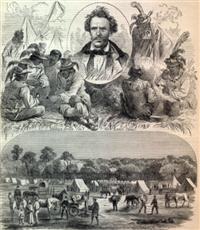 Federal authorities in the west were becoming concerned with reports of jayhawking by troops from Lane's Kansas Brigade. Captain W. E. Prince sent the following message to Lane on September 9, 1861:
Federal authorities in the west were becoming concerned with reports of jayhawking by troops from Lane's Kansas Brigade. Captain W. E. Prince sent the following message to Lane on September 9, 1861:
“I hope you will adopt early and active measures to crush out this marauding which is being enacted in Captain Jennison's name as also yours by a band of men representing themselves as belonging to your command. Captain Wilder will be able to give the details of their conduct at Leavenworth City, and doubtless their atrocities in other localities have been already represented to you. Please have a formal examination into the plundering of private amid public buildings which has recently taken place as I am informed at Fort Scott. It will be necessary for representation to higher authority and for the adjustment of the accounts of disbursing officers.”
The Federal commanders in Missouri were becoming increasingly frustrated with Lane. He had been ordered by Union Major General John C. Fremont to move north and attack the flank of the Missouri State Guard army laying siege to Lexington, Missouri. But Lane had continued his jayhawking ways. He joined up with Jennison's cavalry near Trading Post, Kansas in his pursuit of Price. Lane decided to raid Osceola, Missouri, thinking it was being used as a base of operations for Price's Missouri State Guard. On September 23, 1861, they attacked Osceola and easily drove off a small force of secessionists. When they entered the town, they laid waste to the town, burning it to the ground after taking what plunder was available.
Lane was also becoming frustrated with the restrictions being imposed on him by his superior officers. He decided to go straight to the top in writing the following letter to President Lincoln:
“Since my return from Washington to Kansas I have labored earnestly and incessantly, as commander of the Kansas Brigade, to put down the great insurrection in Missouri. After the State authorities here had failed to collect a force worthy of the name, I, by my own individual efforts and those of my personal friends, despite the opposition of the governor of this State, succeeded in raising and marching against the enemy as gallant and effective an army, in proportion to its numbers, as ever entered the field. Its operations are a part of the history of the country. That brigade to a man are exceedingly desirous of continuing in the service under my command, and I am very anxious to gratify its members in that behalf; but as matters are at present arranged, I feel compelled to abandon the field.
"While the Kansas Brigade was being organized, Governor Charles Robinson exerted his utmost endeavor to prevent the enlistment of men. Since its organization he has constantly, in season and out of season, vilified myself, and abused the men under my command as marauders and thieves. For the purpose of gratifying his malice against me, he has conspired with Captain Prince, the commandant at Fort Leavenworth, to dissolve the brigade, and Captain Prince has apparently heartily espoused the cause in that direction. The latter-named person, in his official capacity, has refused to recognize my authority as commander, and wholly declined to respond to my lawful requisitions upon him for articles and supplies necessary to the efficiency and comfort of the brigade.
"There being no hope of improvement in this condition of things so long as I am in my present position, in order that I may with my brigade remain in the field, and the Government be sustained in this region, and Kansas be protected from invasion from Missouri, I earnestly request and recommend the establishment of a new military department, to be composed of Kansas, the Indian country, and so much of Arkansas and the Territories as may be thought advisable to include therein. After much consideration, and consultation with influential and intelligent gentlemen hereabout, I am decidedly of opinion that this at least should be done, and that the commandant thereof should have under him at least 10,000 troops.
"If this can be done, and I can have the command of the department, I will cheerfully accept it, resign my seat in the Senate, and devote all my thoughts and energies to the prosecution of the war. But if nothing can be done to remedy the evils complained of I will, as above intimated, be compelled to leave my command, quit the field, and most reluctantly become an idle spectator of the great struggle, and witness, I have no doubt, the devastation of my adopted State and the destruction of its people.”
There is no record of Lincoln ever responding to this letter from Lane.
In response to the Federal defeat at Lexington, Fremont took to the field himself and directed all his forces in the western department to come together and move against Sterling Price's Missouri State Guard. Lane was ordered to join up in Kansas City, Missouri with Union Brigadier General Samuel Sturgis and move to Warrensburg, Missouri. They were to continue on to Clinton, Missouri and become part of the army that Fremont was assembling. On the march south through Missouri, Lane's men would protect any slaves that came into their camps and get them safely into Kansas.
 Before Fremont could mount an attack against Price's army, Lincoln would relieve him from command and replace Fremont with Major General David Hunter. On advice received in a letter from Lincoln, Hunter decided to withdraw from Springfield, Missouri and establish bases in Sedalia and Rolla, Missouri. In addition, Hunter sent Lane's Kansas Brigade back into Kansas to guard the border with Missouri. Southern Generals Sterling Price and Ben McCulloch would move into southeastern Missouri to fill the void left behind by the retreating Federals.
Before Fremont could mount an attack against Price's army, Lincoln would relieve him from command and replace Fremont with Major General David Hunter. On advice received in a letter from Lincoln, Hunter decided to withdraw from Springfield, Missouri and establish bases in Sedalia and Rolla, Missouri. In addition, Hunter sent Lane's Kansas Brigade back into Kansas to guard the border with Missouri. Southern Generals Sterling Price and Ben McCulloch would move into southeastern Missouri to fill the void left behind by the retreating Federals.
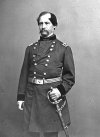 As Lane's Kansas Brigade marched from Springfield, Missouri to Kansas, they continued to pick up slaves. Eventually, the runaways would total more than 200. Upon crossing into Kansas, the slaves were told they were now free men. The Kansas Brigade reach Fort Scott, Kansas on November 14, 1861. It was at this time that Lane found out that he had not been named commander of the newly formed Department of Kansas, headquartered in Fort Leavenworth, Kansas. That distinction went to Major General David Hunter who assumed command on November 20, 1861.
As Lane's Kansas Brigade marched from Springfield, Missouri to Kansas, they continued to pick up slaves. Eventually, the runaways would total more than 200. Upon crossing into Kansas, the slaves were told they were now free men. The Kansas Brigade reach Fort Scott, Kansas on November 14, 1861. It was at this time that Lane found out that he had not been named commander of the newly formed Department of Kansas, headquartered in Fort Leavenworth, Kansas. That distinction went to Major General David Hunter who assumed command on November 20, 1861.
Lane did not stay in Fort Scott long and left for Washington. Along the way Lane gave numerous speeches in which he would describe the great work performed by his Kansas Brigade. Lane continued to argue for encouraging southern slaves to run away to their freedom in northern states. Lane arrived in Washington in time to serve as Kansas Senator in the next session of the US Congress.
General Lane's Expedition

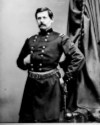 After the congressional session ended, Lane returned to Kansas in January 1862 to try and regain control of his Kansas Brigade from Major General David Hunter. Lane had been arguing in speeches for a military expedition into southern states for the purpose of freeing slaves. He had received Major General George McClellan's endorsement for such an expedition. Lane, of course, wanted to lead this expedition. In a letter from McClellan to Hunter on January 24, 1862:
After the congressional session ended, Lane returned to Kansas in January 1862 to try and regain control of his Kansas Brigade from Major General David Hunter. Lane had been arguing in speeches for a military expedition into southern states for the purpose of freeing slaves. He had received Major General George McClellan's endorsement for such an expedition. Lane, of course, wanted to lead this expedition. In a letter from McClellan to Hunter on January 24, 1862:
“By direction of the General-in-Chief I have respectfully to inform you that Brig. Gen. J. H. Lane, U. S. Volunteers, has urged upon the President and Secretary of War an expedition to be conducted by him from Fort Leavenworth against the region west of Missouri and Kansas [Arkansas]. The outlines of his plan were stated by him to be in accordance with your own views. The following force, with supplies therefor, has been ordered to Kansas to operate under General Lane: Seven regiments cavalry, three batteries artillery, four regiments infantry, and he has been authorized also to raise about 8,000 to 10,000 Kansas troops and to organize 4,000 Indians.”
However, Hunter was one step ahead of him and on January 27, 1862, issued General Order No. 11 which included the following statement:
“In the expedition about to go south from this department, called in the newspapers General Lane's Expedition, it is the intention of the major-general commanding the department to command in person, unless otherwise expressly ordered by the Government.”
 But Lane and his supporters continued their lobbying. Lincoln, who owed both men a great deal, finally decided in favor of Hunter. On January 31, 1862 he sent the following message to his Secretary of War, Edwin Stanton:
But Lane and his supporters continued their lobbying. Lincoln, who owed both men a great deal, finally decided in favor of Hunter. On January 31, 1862 he sent the following message to his Secretary of War, Edwin Stanton:
“It is my wish that the expedition commonly called the Lane Expedition shall be ... but a snug, sober column of 10,000 or 15,000. General Lane has been told by me many times that he is under the command of General Hunter, and assented to it as often as told. It was the distinct agreement between him and me when I appointed him that he was to be under Hunter.”
On February 10, 1862, Lincoln brought the conflict to its conclusion by sending the following message to both Hunter and Lane:
“My wish has been and is to avail the Government of the services of both General Hunter and General Lane, and, so far as possible, to personally oblige both. General Hunter is the senior officer and must command when they serve together; though in so far as he can, consistently with the public service and his own honor, oblige General Lane, he will also oblige me. If they cannot come to an amicable understanding, General Lane must report to General Hunter for duty, according to the rules, or decline the service.”
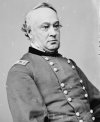
 Lane continued to vacillate on whether or not he would accept a commission and serve under Hunter. Lane was reluctant to give up commanding the expedition and continued to work on preparations. On February 13, 1862, Halleck complained to McClellan about Lane, “All orders for sending troops to Kansas should be sent through me. Lane has been giving orders right and left in my department. This must be stopped.” To which McClellan immediately replied, “Lane had no authority to give any orders. Countermand all that did not come from the Adjutant-General of the Army.” Halleck would put stop the the troop movements and for all intents and purposes put an end to “Lane's Expedition.” Lane, too, realized it was over and sent a telegram to Lincoln on February 16th declining the commission.
Lane continued to vacillate on whether or not he would accept a commission and serve under Hunter. Lane was reluctant to give up commanding the expedition and continued to work on preparations. On February 13, 1862, Halleck complained to McClellan about Lane, “All orders for sending troops to Kansas should be sent through me. Lane has been giving orders right and left in my department. This must be stopped.” To which McClellan immediately replied, “Lane had no authority to give any orders. Countermand all that did not come from the Adjutant-General of the Army.” Halleck would put stop the the troop movements and for all intents and purposes put an end to “Lane's Expedition.” Lane, too, realized it was over and sent a telegram to Lincoln on February 16th declining the commission.
Military Command Reorganization in Kansas

 On February 28, 1862, Hunter, in cooperation with Kansas Governor Charles Robinson, would issue General Order No.26. This reorganized the Kansas regiments and further reduced Lane's role and power in the US Army.
On February 28, 1862, Hunter, in cooperation with Kansas Governor Charles Robinson, would issue General Order No.26. This reorganized the Kansas regiments and further reduced Lane's role and power in the US Army.
On March 11, 1862, the Department of Kansas was dissolved and the District of Kansas became part of the Department of the Mississippi under the command of Major General Henry Halleck. 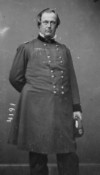 Major General David Hunter was transferred to South Carolina and Halleck put Brigadier General James W. Denver in command of the District of Kansas. In late 1861, Denver had actively challenged Lane's authority to be in command of the Kansas Brigade. Now Lane strongly protested Denver's appointment.
Major General David Hunter was transferred to South Carolina and Halleck put Brigadier General James W. Denver in command of the District of Kansas. In late 1861, Denver had actively challenged Lane's authority to be in command of the Kansas Brigade. Now Lane strongly protested Denver's appointment.
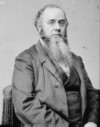 In a message to Halleck, US Secretary of War Stanton explained why he ignored this protest:
In a message to Halleck, US Secretary of War Stanton explained why he ignored this protest:
“Some days ago Senators Pomeroy and Lane presented to the President a protest against General Denver having command of the Kansas troops. It was referred to the Secretary of War. I indorsed upon it that General Halleck should do as he thought best for the service, and transmitted it to you by mail. I think the President would rather the troops should not be under General Denver's command, but on a question of that nature it is my opinion the matter should be left to the commander of the department, who is responsible for the service, and with him I leave it.”
On March 28, 1862, Halleck issued Special Orders No. 49 putting Denver in command at Fort Leavenworth :
“Brig. Gen. J. W. Denver ... will ... proceed to Fort Leavenworth and assume command of the District of Kansas.”
 But Lane continued to press his desires to President Lincoln. Lincoln expressed this in a message to Halleck on April 4, 1862:
But Lane continued to press his desires to President Lincoln. Lincoln expressed this in a message to Halleck on April 4, 1862:
“I am sorry to learn that after all General Denver has gone to Kansas. Cannot General Davies go there? There is a hard pressure on me in this matter.”
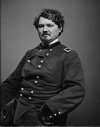 On April 6, 1862, Halleck acquiesced to Lincoln's wishes and issued Special Orders No. 77:
On April 6, 1862, Halleck acquiesced to Lincoln's wishes and issued Special Orders No. 77:
“Brig. Gen. S. D. Sturgis is hereby assigned to the command of the District of Kansas. He will immediately repair to Fort Leavenworth and relieve Brigadier-General Denver.”
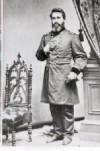 There were continued reorganizations in the military command structure in Kansas. On May 2, 1862, Washington reestablished the Department of Kansas and on May 5,1862 Brigadier General James G. Blunt assumed command. Blunt was a protege and ardent supporter of Lane. So Lane was able to keep his position as US Senator and still had considerable influence over military matters in Kansas.
There were continued reorganizations in the military command structure in Kansas. On May 2, 1862, Washington reestablished the Department of Kansas and on May 5,1862 Brigadier General James G. Blunt assumed command. Blunt was a protege and ardent supporter of Lane. So Lane was able to keep his position as US Senator and still had considerable influence over military matters in Kansas.
Recruiting Commissioner
In July 1862 Lane became a recruiting commissioner for the State of Kansas. As a recruiting commissioner, Lane was instrumental in mustering in the First Kansas Colored Volunteers, the first regiment of African American troops to see action on the side of the Union during the Civil War.
Quantrill's Raid on Lawrence
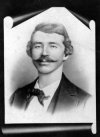 A long time resident of Lawrence, Kansas, Lane was one of the primary targets sought during Quantrill's Raid that led to the killing of between 185 and 200 men and boys on August 21, 1863. According to legend, Lane escaped by running out an hiding in some corn fields, while still in his night shirt.
A long time resident of Lawrence, Kansas, Lane was one of the primary targets sought during Quantrill's Raid that led to the killing of between 185 and 200 men and boys on August 21, 1863. According to legend, Lane escaped by running out an hiding in some corn fields, while still in his night shirt.
Later that day, Lane regrouped and organized a small group of locals and soldiers, under the command of Lieutenant John K. Rankin, to harass Quantrill's rear guard. Quantrill's partisans also were being pursued by a combined force of about 100 Federal cavalry under the command of Major Preston B. Plumb. Lane would meet up with the Federals to help in their pursuit of Quantrill. But Plumb divided his forces in an attempt to attack Quantrill from two sides. Quantrill turned and attacked the force in his rear and successfully drove off the Federals. Quantrill and his man were able to escape by breaking off into small groups.
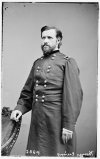 The next day, Lane would arrange a meeting with the Federal commander of the District of the Border, Brigadier General Thomas Ewing, Jr. to discuss the Federal response to Quantrill's raid. Lane was furious with Ewing's failure to prevent Missouri Partisan raids into Kansas. Lane argued for Ewing to take greater measures and threatened to use his influence in Washington against Ewing. Three days later on August 25, 1863, Ewing issued the infamous General Orders No.11. This order required all persons living in Jackson, Cass, Vernon and Bates counties, Missouri to leave their places of residence within 15 days.
The next day, Lane would arrange a meeting with the Federal commander of the District of the Border, Brigadier General Thomas Ewing, Jr. to discuss the Federal response to Quantrill's raid. Lane was furious with Ewing's failure to prevent Missouri Partisan raids into Kansas. Lane argued for Ewing to take greater measures and threatened to use his influence in Washington against Ewing. Three days later on August 25, 1863, Ewing issued the infamous General Orders No.11. This order required all persons living in Jackson, Cass, Vernon and Bates counties, Missouri to leave their places of residence within 15 days.
However, this was not enough for Lane, the “Grim Reaper,” who held a rally in Leavenworth, Kansas calling for an armed expedition into Missouri in order to get revenge for the Lawrence Massacre. But nothing came from this rally.
Price's Raid into Missouri
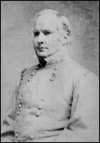
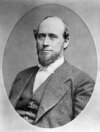 As Confederate Major General Sterling Price began to move his army west across Missouri, Senator Lane was one of the individuals who would argue strongly for Kansas Governor Thomas Carney to mobilize the state militia in defense of the border. Eventually, Carney would call up the militia and they would be important in helping defeat Price's army at the Battle of Wesport.
As Confederate Major General Sterling Price began to move his army west across Missouri, Senator Lane was one of the individuals who would argue strongly for Kansas Governor Thomas Carney to mobilize the state militia in defense of the border. Eventually, Carney would call up the militia and they would be important in helping defeat Price's army at the Battle of Wesport.
During Price's Raid into Missouri is the fall of 1864, Lane was involved in the planning for the pursuit of the retreating Confederates following their defeat at the Battle of Westport. He wanted to be sure that the Kansas Volunteers would be able to get leave in order to vote in the fall elections in 1864.
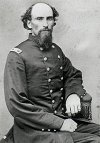
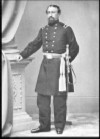 Lane continued to accompany the Federal army in pursuit of Price's retreating army. Just before the The Battle of Charlot's Farm (Marmaton River), Union Brigadier General John McNeil would send Senator Lane back for reinforcements.
Lane continued to accompany the Federal army in pursuit of Price's retreating army. Just before the The Battle of Charlot's Farm (Marmaton River), Union Brigadier General John McNeil would send Senator Lane back for reinforcements.
Kansas Senator James H. Lane's call for mobilization of the militia had been initially opposed by Kansas Governor Thomas Carney. By being associated with the victory at Mine Creek, the entire Lane ticket was elected. Samuel Crawford, also present at Mine Creek, was elected Governor of Kansas.
Post-Civil War Role
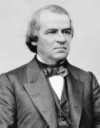 Reelected to the Senate in 1865, Lane would throw his support behind beleaguered President Andrew Johnson's reconstruction policies. In doing so he drew the wrath of the Radical Republicans. They attacked him, accusing him of fraudulent financial dealings. In fit of depression, Lane shot himself on July 1, 1866. He would die 10 days later on July 11, 1866. James Henry Lane was buried in Oak Hill Cemetery, 1605 Oak Hill Ave., Lawrence, KS 66044.
Reelected to the Senate in 1865, Lane would throw his support behind beleaguered President Andrew Johnson's reconstruction policies. In doing so he drew the wrath of the Radical Republicans. They attacked him, accusing him of fraudulent financial dealings. In fit of depression, Lane shot himself on July 1, 1866. He would die 10 days later on July 11, 1866. James Henry Lane was buried in Oak Hill Cemetery, 1605 Oak Hill Ave., Lawrence, KS 66044.
Sites of Interest
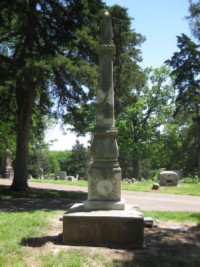 James H. Lane Grave Site
James H. Lane Grave Site
Oak Hill Cemetery, 1605 Oak Hill Ave., Lawrence, KS 66044
| Waypoint = N38 57.481 W95 12.723 | Map |
General Orders No. 11 Historical Marker
401 Delaware Street, Kansas City, MO 64105
| Waypoint = N39 6.526 W94 35.065 | Map |
References
- Benedict, Bryce D. Jayhawkers : Jayhawkers: The Civil War Brigade of James Henry Lane
. Norman: University of Oklahoma Press, 2009.
- Gilmore, Donald L. Civil War on the Missouri-Kansas Border
Gretna: Pelican, 2006.
- Collins, Robert. Jim Lane : Scoundrel, Statesman, Kansan. Gretna, La.: Pelican Pub. Co., 2007.
- Kansas National Guard Museum. Historic Units. http://www.kansasguardmuseum.org/kngunits.html Accessed October 23, 2009.
- Spurgeon, Ian Michael. Man of Douglas, Man of Lincoln
. Columbia: University of Missouri Press, 2008.
- U.S. War Department. The Civil War CD-Rom: The Official Records of the War of Rebellion (128 vol. on one cd)
. Washington, D.C.: United States Government Printing Office, 1880-1901. Series 1, Volume 3.
- U.S. War Department. The Civil War CD-Rom: The Official Records of the War of Rebellion (128 vol. on one cd)
. Washington, D.C.: United States Government Printing Office, 1880-1901. Series 1, Volume 8.
- U.S. War Department. The Civil War CD-Rom: The Official Records of the War of Rebellion (128 vol. on one cd)
. Washington, D.C.: United States Government Printing Office, 1880-1901. Series 1, Volume 13.
- U.S. War Department. The Civil War CD-Rom: The Official Records of the War of Rebellion (128 vol. on one cd)
. Washington, D.C.: United States Government Printing Office, 1880-1901. Series 1, Volume 17.
- U.S. War Department. The Civil War CD-Rom: The Official Records of the War of Rebellion (128 vol. on one cd)
. Washington, D.C.: United States Government Printing Office, 1880-1901. Series 1, Volume 53.
Back: John Charles Fremont
Next: Charles Rainsford Jennison
